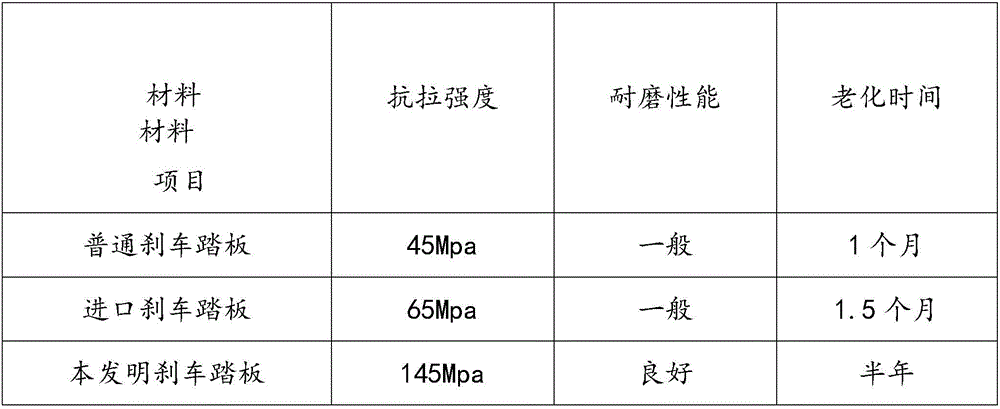Material of automobile brake pedal and preparation method thereof
A technology for automobile brakes and pedals, which is applied in the field of materials and preparation of automobile brake pedals, can solve the problems of low structural strength, low technical content, and no attention to intellectual property protection, and achieves the effect of high structural strength.
- Summary
- Abstract
- Description
- Claims
- Application Information
AI Technical Summary
Problems solved by technology
Method used
Image
Examples
Embodiment 1
[0018] A material for an automobile brake pedal, made of the following materials in parts by weight, including 66 parts of polyamide, 12 parts of polyphenylene sulfide, 22 parts of glass fiber, 15 parts of carbon black, 11 parts of aluminum hydroxide, 7 parts of aluminoxane, 3 parts of zirconocene dichloride, 22 parts of p-phenylenediamine, 6 parts of ethoxyquinoline, 6 parts of maleic anhydride, 12 parts of polybutadiene latex, 1 part of styrene-butadiene latex, 14 parts of borax, 3 parts of epoxidized soybean oil, 7 parts of ammonium polyphosphate, 11 parts of zinc borate, 20 parts of dioctyl phthalate, 7 parts of potassium titanate whiskers and 11 parts of benzoyl peroxide.
[0019] A preparation method for a material of an automobile brake pedal, comprising the following steps:
[0020] 1) 66 parts of polyamide, 12 parts of polyphenylene sulfide, 22 parts of glass fiber, 15 parts of carbon black, 11 parts of aluminum hydroxide, 7 parts of methyl aluminoxane, 3 parts of zir...
Embodiment 2
[0026] A material for an automobile brake pedal, made of the following materials in parts by weight, including 68 parts of polyamide, 13 parts of polyphenylene sulfide, 23 parts of glass fiber, 17.5 parts of carbon black, 12.5 parts of aluminum hydroxide, 9.5 parts of aluminoxane, 4 parts of zirconocene dichloride, 23 parts of p-phenylenediamine, 7.5 parts of ethoxyquinoline, 9 parts of maleic anhydride, 15 parts of polybutadiene latex, 1.5 parts of styrene-butadiene latex, 16 parts of borax, 5.5 parts of epoxidized soybean oil, 7.5 parts of ammonium polyphosphate, 12.5 parts of zinc borate, 21 parts of dioctyl phthalate, 8.5 parts of potassium titanate whiskers and 13.5 parts of benzoyl peroxide.
[0027] A preparation method for a material of an automobile brake pedal, comprising the following steps:
[0028] 1) 68 parts of polyamide, 13 parts of polyphenylene sulfide, 23 parts of glass fiber, 17.5 parts of carbon black, 12.5 parts of aluminum hydroxide, 9.5 parts of methyl ...
Embodiment 3
[0034] A material for an automobile brake pedal, made of the following materials in parts by weight, including 70 parts of polyamide, 14 parts of polyphenylene sulfide, 24 parts of glass fiber, 20 parts of carbon black, 14 parts of aluminum hydroxide, 12 parts of aluminoxane, 5 parts of zirconocene dichloride, 24 parts of p-phenylenediamine, 9 parts of ethoxyquinoline, 12 parts of maleic anhydride, 18 parts of polybutadiene latex, 2 parts of styrene-butadiene latex, 18 parts of borax, 8 parts of epoxidized soybean oil, 8 parts of ammonium polyphosphate, 14 parts of zinc borate, 22 parts of dioctyl phthalate, 10 parts of potassium titanate whiskers and 16 parts of benzoyl peroxide.
[0035] A preparation method for a material of an automobile brake pedal, comprising the following steps:
[0036] 1) 70 parts of polyamide, 14 parts of polyphenylene sulfide, 24 parts of glass fiber, 20 parts of carbon black, 14 parts of aluminum hydroxide, 12 parts of methyl aluminoxane, 5 parts o...
PUM
 Login to View More
Login to View More Abstract
Description
Claims
Application Information
 Login to View More
Login to View More - R&D
- Intellectual Property
- Life Sciences
- Materials
- Tech Scout
- Unparalleled Data Quality
- Higher Quality Content
- 60% Fewer Hallucinations
Browse by: Latest US Patents, China's latest patents, Technical Efficacy Thesaurus, Application Domain, Technology Topic, Popular Technical Reports.
© 2025 PatSnap. All rights reserved.Legal|Privacy policy|Modern Slavery Act Transparency Statement|Sitemap|About US| Contact US: help@patsnap.com

